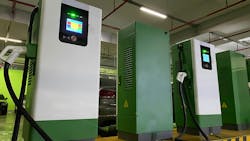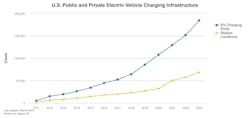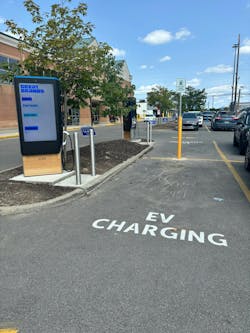Implementing EV Charging Safely Through Codes and Standards
Unless you have spent the past few years stranded on an island with only a volleyball to communicate with, you have seen the world around us begin to change as it relates to vehicular transportation. Many automakers have set lofty goals that include production shifts from the longtime manufactured internal combustion engine (ICE) vehicles to battery-operated electric vehicles (EVs). While some of those automakers have shifted their initial goals slightly — based on the economics of current supply and demand — it appears that EVs will take us where we need to go.
As there are likely several areas where consumers may feel apprehension in purchasing EVs, one glaring issue is likely to be the convenience of being able to charge the vehicle whenever it’s needed. After all, we have become accustomed to gas stations being on every corner to fuel our ICE vehicles.
A report from May 2024 provided by the Pew Research Center further supports this logic, providing data that those who live close to EV chargers are likely to say they already own an EV, would consider buying an EV, favor phasing out production of ICE vehicles, and/or have confidence in the EV charging infrastructure being built that will support the need. The same report also states that 64% of Americans currently live within two miles of a public EV charging station, clearly indicating a gap still exists when it comes to access to EV charging.
Data from the U.S. Department of Energy (USDOE) shows the continued growth of the public and private EV charging infrastructure — both the number of charging ports (EV chargers) available and EV charging station locations. This translates to not only more EV chargers for consumers to use but also the likelihood that the convenience of accessing those chargers has risen based on the number of charging stations increasing as well. As of the end of 2023, the USDOE data showed there were 184,908 EV charging ports available in the country spread across 68,475 EV charging stations (see the Figure below). While growth is a good thing when it comes to the EV charging infrastructure, safe growth is an even better thing.
That is where the National Fire Protection Association (NFPA) codes and standards can help. The use of applicable NFPA codes and standards can help to keep EV charger infrastructure installations safer for the communities they are installed in and for those citizens who will directly utilize them.
NFPA 70, National Electrical Code (NEC)
Enforced in all 50 states, the NEC is the foundational component of electrical installations that keeps people and property safe. As part of the consensus-based NFPA Standards Development Process, the NEC is updated every three years with input from the general public and diverse Code-making panels with a significant amount of expertise in the electrical industry. These revisions often consider and include updates that safely incorporate technology advancements, of which EVs are no exception.
Article 625 in the 2023 edition of the NEC is titled “Electric Vehicle Power Transfer System.” The title of this Article is new, having been changed just one Code cycle ago in the 2020 NEC. Prior to that change being made in 2020 — from 2017 back to the 2002 edition of the NEC — Art. 625 was titled “Electric Vehicle Charging System.” That’s because it was always about the safe charging of the electric vehicle. However, advancements in EV technology that incorporate bidirectional current flow now permit the EV to not only be charged by the premises power system but also for the EV itself to supply power back to the premises wiring system. Based on that change in technology and the ability of EV supply equipment (EVSE) to have bidirectional power ability, there needs to be NEC requirements utilized in order to maintain the ability of the EV to be charged safely and also for it to interact safely with premises wiring systems, when the EV is supplying power back in that direction. Currently, only 37 of 50 states enforce the 2020 or 2023 NEC. This means that, although the EVSE that will be installed as part of the EV charging infrastructure in the United States likely has the ability to provide bidirectional power, many states are left without the ability to incorporate NEC requirements that address this technology in order to keep installations and users safe. This is just one example that illustrates how using the most current NEC is critical in making sure continuously evolving technologies and safety remain aligned.
NFPA 70B, Standard for Electrical Equipment Maintenance
While electrical equipment maintenance isn’t often thought of at the installation stage, it should be. A substantial amount of investment (both public and private) is being made into building the EV charging infrastructure. Ensuring the reliability and longevity of the equipment being installed should be carefully considered — not to mention the continual rate of use and, in turn, the wear-and-tear that this equipment will see over a short amount of time will cause the need for regular maintenance to keep the equipment safe for users. That is where NFPA 70B, Standard for Electrical Equipment Maintenance, can help.
Chapter 33 of NFPA 70B identifies electrical maintenance requirements for electric vehicle power transfer systems and associated equipment. It should be noted that none of the requirements that NFPA 70B provides are intended to supersede instructions that are provided by the equipment manufacturer, which should be adhered to. Often, the requirements found within NFPA 70B are likely to take maintenance beyond the directives provided by manufacturers.
When it comes to electrical equipment maintenance, even when dealing with specific equipment such as that utilized for EV power transfer, the overarching goal of NFPA 70B is to develop an overall electrical maintenance program (EMP) that addresses the electrical equipment maintenance needs of the entire facility. That is important to keep in mind as we touch on some of the Chapter 33 requirements.
One of the main components of maintenance addressed with EV power transfer equipment is how often it needs to be maintained. Several variables can impact the required frequency of maintenance that center around equipment condition based on three criteria: the physical condition; the criticality of the equipment; and the operating environment. All these items, as well as prior performed and documented maintenance on the equipment, can play a role in how frequent forthcoming maintenance must be performed. Additionally, NFPA 70B provides requirements around specific tasks for visual inspections of the equipment and the documentation that must be maintained as maintenance is performed. Without proper maintenance of EV power transfer equipment, reliability and safety are lost.
As the world of transportation changes and EVs become more prevalent, it is important that a nationwide charging infrastructure is in place that is both reliable and safe for consumers to utilize. For electrical professionals working in these spaces, incorporating the most current NFPA codes and standards as part of ongoing installations and maintenance being performed in communities is a great step toward providing just that.
Important Notice: Any opinion expressed in this column is the personal opinion of the author and does not necessarily represent the official position of NFPA or its Technical Committees. In addition, this piece is neither intended, nor should it be relied upon, to provide professional consultation or services.
About the Author
Corey Hannahs
Corey Hannahs is a senior electrical content specialist at the National Fire Protection Association (NFPA). In his current role, he serves as an electrical subject matter expert in the development of products and services that support NFPA documents and stakeholders. Corey is a third-generation electrician, holding licenses as a master electrician, contractor, inspector, and plan reviewer in the state of Michigan. Having held roles as an installer, owner, and executive previously, he has also provided electrical apprenticeship instruction for over 15 years. He serves on the technical committees for UL 2272, Electrical Systems for Personal E-Mobility Devices, and UL 2849, Electrical Systems for Ebikes. Corey was twice appointed to the State of Michigan’s Electrical Administrative Board by former Governor Rick Snyder, and he received United States Special Congressional Recognition for founding the B.O.P. (Building Opportunities for People) Program, which teaches construction skills to homeless and underprivileged individuals. He can be reached at [email protected].



